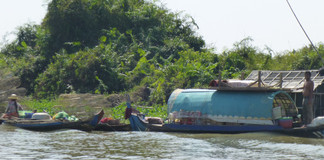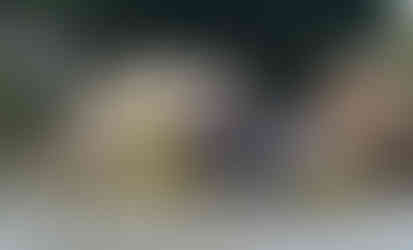Adventures in Cambodia:
- Bev Baraka
- Feb 19, 2022
- 7 min read
Updated: Sep 26, 2024
From River Cruise to the Capital

To get from Siem Reap where the Angkor Wat complex is to Phnom Pen we took a river boat along the Mekong River. It's not really a 'cruise' but more like a river taxi. The advantage is that it was cooler than a vehicle might have been, with a constant breeze, but it also allows you to see the way locals live on and along the water.
The waterways in Asia are super important to the economy of the area. People live on boats on

on the water. Some plant crops on floating gardens. Villages on the Mekong river become hubs for transportation since many roads end at the water. You see floating shops and boats piled high that wiz by on their way to deliver the produce to another store farther along the river. Some boats are powered by poles and oars while others race by with a motor - spewing water behind them. It is more likely that you'll find empty spots along the roadside than finding empty spots along the river.

We stopped for lunch on a floating restaurant on the Mekong River and they had crocodiles in a center cage, sunk into the water with a walkway around it.

Very strange to me and I kept well back since crocodiles/alligators and snakes are not among my favorite animals. But it was all part of the adventures of another culture.
Boat mishap on the Mekong:
It seems when I travel I often get some kind of injury - either myself or my luggage. I guess I should be happy I have had only a limited number of injuries but on this trip I did get injured. So my

adventures in Cambodia were not without mishap. As the boat pulled into a dock I was taking pictures and did not realize my arm was outside the boat. The boat next to us was tying up to the dock and slammed against our boat a couple of times. It got closer and too late I realized my arm was in the way. It got mashed between the two boats. I couldn't get it out until another passenger helped push the other boat away. I was happy not to see any blood but their was sharp pain deep in my arm. An open wound could have got infected from the polluted water of the Mekong River so I was glad it was just muscular. I had no option but to grind my teeth and bear it--we had barely begun our trip! I took several aspirin and kept it still for a while until the pain took on a dull drum beat that I could handle. The skin was not broken but I had a huge bruise on my upper arm - on the inside and outside of my arm. The picture just shows one side. I could feel it for a few days and had to baby it a bit. I found my big camera too hard to manage without pain and so many of my photos were taken with my little Lumix for the following days.
Land of the Killing Fields in Phnom Penh

This is a tragic history for Cambodia. You see remnants of it today from un-exploded land mines to untouched bullet ridden buildings. As you shop and tour the Phnom Penh area you see different reactions from the people: some still don't trust foreigners and others jump at new opportunities and are thankful for the life they now have. I gathered from my readings and tours that the genocide started after the civil war when the Khmer Republic fell and the dictator Pol Pot took over. Phnom Penh (now the capitol) was the last holdout and when it fell, Pol Pot pushed in and took his revenge. Anyone involved in the war against the Khmer Rouge (the communist regime of Pol Pot) were executed in huge numbers. Civilians were the next target and as they fled into the countryside,1000's were killed. Fearing they or a family member would be taken, Cambodians rushed to the Thailand border where refugee camps were created while others flooded the French Embassy.


Anyone supporting any kind of Western ideas or even products were seen as committing treason and they were arrested and sent to re-education camps which were really torture camps. Many of these were in and around Phnom Penh. I toured one that was referred to as 'The Killing Fields', just outside Phnom Penh. It was there they found mass graves. Pits with 100s of skeletons - adult and children. Often the adults were forced to dig these pits before they were slaughtered and thrown into them -- digging their own graves. On the site you can see a building filled with the skulls they found. Gruesome, true. But it is eye-opening and important to see and understand what the country and the people went through. How could they have come out so normal and happy to re-build their country after their ancestors were treated this way? It shows the resilience of humans.

The grounds of this area - the main 'killing field' is almost park-like now. It has paths and memorial signs everywhere. It is a beautiful landscape but there is a darkness over it. On one path is a tree covered in ribbons, beaded bracelets and bits of material. It is to represent the children murdered there. Babies and infants were smashed against trees to kill them. Brutality fostered by fear of one man's evil desires. His army followed his lead or they would die. He was the leader but many of the Khmer Rouge were given free reign of their own dark tendencies. It is heartbreaking to see the evidence of his slaughter. You can only take so much of this before you must move on to happier endeavors - finding something uplifting to do.
There is a book that will give some insight into what really happened. A young boy survived the Khmer Rouge army and lived. It started with his village fleeing to a better place but he was caught up in the war. I read it just after I went to Cambodia and I wished I had read it before. It is "Never Fall Down": Surviving the Killing Fields and is actually written by Patricia McCormick. If you are interested in this part of the world you should read it.
Tuol Sleng, Phnom Penh: Re-education Center


The last tour I took on this theme was to the Execution Center Tuol Sleng that is in Phnom Penh and is one of the most well known. Pol Pot and his army commandeered a school and made it into a torture school or a 'factory of death.' It is estimated that over 20,000 people were locked up in this compound and only seven are known to have gotten out alive. As you tour it now you see a building full of small cubicles that were made into cells. Apart from the cells, there were torture rooms on one side of compound and a hanging rack outside. Some deaths were public displays while others were done in secret and the brutality enacted here is only guessed at today.


There is a plaque (left) showing the hanging rack with urns full of water used for torture. A current photo (right) shows the actual hanging rack - still standing in the courtyard of the building - with the urns sitting underneath it.
The torture and genocide stopped only when the Vietnamese invaded Cambodia in 1979. It had gone on for four long years. Historians believe there were over 150 'Re-Education Centers' across Cambodia and within those four years almost 3 million people entered them -- most did not come out. That was almost 25% of the population at the time.
Cambodian Countryside now:

We did not travel into the countryside much but did take one trip - away from the Mekong River. The countryside of Cambodia is beautiful but again there is a sad story - much of it is still unusable because of landmines that still hide just under the soil. There are whole sections of the country that are uninhabited because landmines still exist there. Various organizations help to find and explode the landmines but it is a never ending job. A small museum on the way showed remnants found in the country - steel cylinders, landmine shells, rebar, metal car parts. People cannot farm until the land is cleared. Using big equipment might cause vibrations that could explode hidden mines so farmers use simple equipment -- at least where we visited. They are brave to live outside of Phnom Penh.

Unfortunately, scrap metal is a big business and children will go into the bush looking for metal left over from the war. Stories on the wall of the little museum explained that sometimes they see metal sticking up from the ground and they dig to get it out only to find it is a landmine -- sometimes they disturb it and it explodes. Pictures showed some of the damage from exploding mines and the injuries sustained by those that survived. You might also see older men with injuries from the war, both in Phnom Penh and the country areas.
We wanted to visit smaller temples and see how they were different from Angkor Wat and the one we headed to was high, on top of a hill. There were so many steps. Just looking at them was daunting, but we started the climb. We rested now and then but finally made it to the top.
The temple was small and very old - historical Cambodia. People still go there as you could see incense burning and it was swept clean in areas. The structure was similar to what we had seen at Angkor Wat - high towers, built with stacking stone or bricks. A center area was more open and room-like and of course there were little shelves or cubbies for statues.



























Comentarios